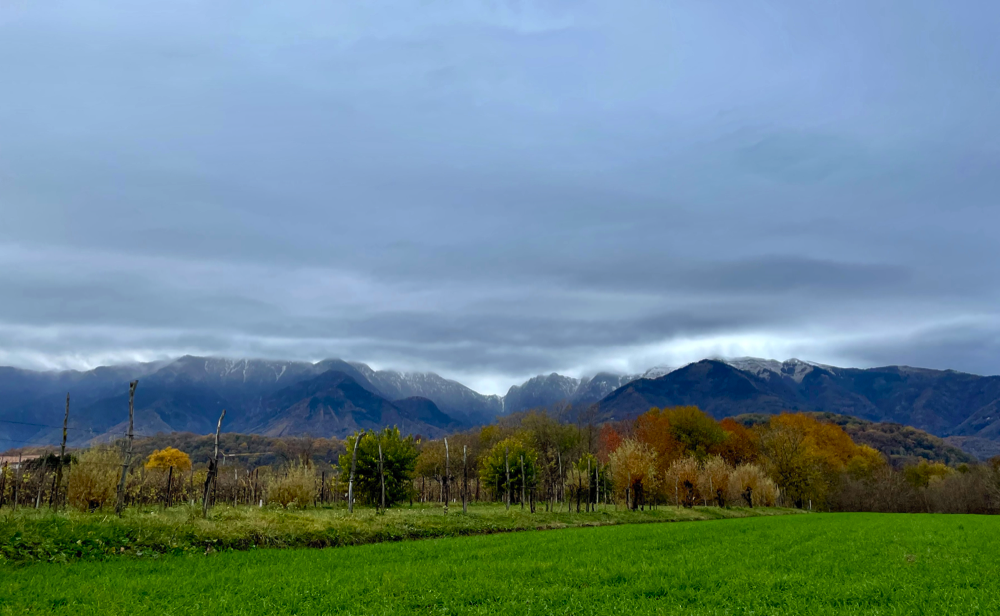
Trenches and craters scar the surface of Monte Grappa
(Apple Maps image)
More than a mountain, it's a massif, a world unto itself, a legendary place bearing the scars of battle and an atmosphere of tragedy and sadness. For it is hallowed ground, the final resting place of thousands of young men who died gallantly for their country. It is also a destination for hikers, hang gliders and paragliders, cyclists and gravel and mountain bikers, history buffs, climbers, naturalists, motor sports enthusiasts, nordic walkers, pic-nickers, and seekers of silence and tranquility. It's our "backyard mountain," ever-changing: sometimes sunny, green and inviting, at other times dark and forbidding or mist-cloaked and mysterious, always dominating the landscape as well as the imagination.
Mountain Facts...
• Monte Grappa is part of the Venetian Prealps. It spans the provinces of Treviso, Vicenza, and Belluno. The summit is in the municipality of Pieve del Grappa (ex Crespano del Grappa), in the province of Treviso.
• height: 1775 m (5769 ft); vertical gain from Romano d'Ezzelino: 5230 ft. (in 16 miles)
• distance around the massif: about 100 km (62 mi.)
• Peaks of the massif include: Cima Grappa, Col del Orso, Col della Berretta, Col Moschin, Col del Miglio, Col Caprile, Monte Prassolan, M. Fontana Secca, M. Palla, M. Asolone, M. Pertica, M. Pallon, M. Boccaor, M. Oro, M. Coston, M. Meda, M. Piz, M. Roncone, M. Boscon, M. Cismon, M. Solarolo, M. Cornosega, M.Tomba, M. Santo, M. Tomatico, M. Meatte, Cima della Mandria. Some of the small locales and settlements are Costalunga, Lepre, Ponte San Lorenzo, Campo Solagna, Campo Croce, San Giovanni, Forcelletto, Finestron, and Spinoncia.
• Monte Grappa has recently become a UNESCO Biosphere Reserve.
In World War I the Italians were engaged in a deadly struggle against the invading Austrians, who had routed them at Caporetto and were poised to invade the Veneto plains. If they had succeeded, Italy would have been lost. The Italian army regrouped and prepared for its heroic last stand along the Piave River and the adjacent mountain massif--Monte Grappa--which they had transformed into a fortress, with tunnels, bunkers, trenches, and gun emplacements blasted from solid rock (they can still be seen and explored today). Every Italian citizen joined in the effort, contributing whatever they could to help their soldiers. The troops fought numerous battles, first defensive, then taking the offensive and repelling the invaders forever. The monument and ossuary on Cima Grappa are a testament of the tragic cost: there lie the bones of 12,615 Italians and 10,295 Austro-Hungarians who never came down from the mountain. The remains of many others continue to be discovered--thirteen of them in 2019 alone--along with their helmets, uniforms, boots, canteens, weapons, and sometimes, ID tags. • Click here to see photo albums of mountain warfare in WWI. • Click here to read an excellent in-depth article about the battles on Monte Grappa.
The Madonna was hit by a shell and damaged, but the soldiers saved the beloved statue, which was restored, and it continues to watch over the mountain top.
Read my CyclingNews article
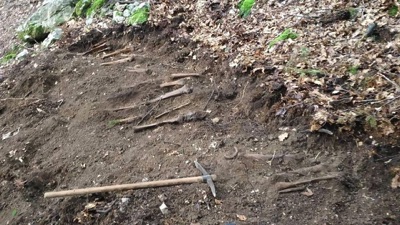
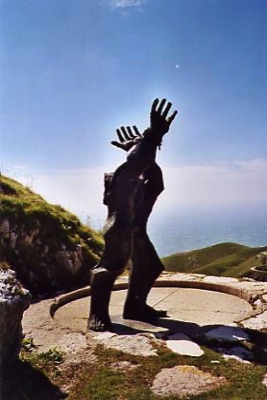
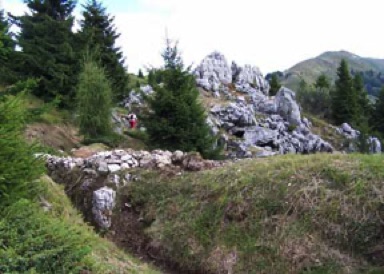
Monument to the Partisans
Restored trenches
The remains of WW1 fallen
Photo from a local newpaper
Learn more about WW1 in the Veneto
It was in August of 1901 that the patriarch of Venice, Beppe Sartor of nearby Riese (who would later become Pope Pius X), arrived in Borso del Grappa to start his trek to Cima Grappa to bless a new statue of the Madonna. He was surprised to find a large group of pious townspeople waiting to accompany him on the journey, which he made astride a white mule. This event has entered into local legend and was reenacted in 2001, on its 100th anniversary.
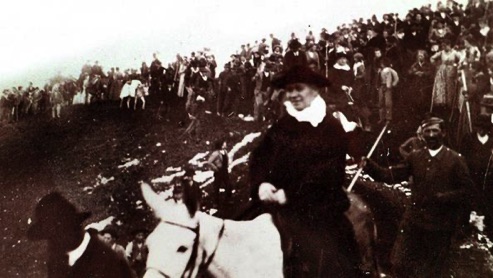
A Little History, and More...
The origin of its name is unertain. One hypothesis is that it was derived from crapp or grepp, meaning crag in an ancient pre-Latin language (there are indeed mountains named Monte Crep, Crep Nudo, et al). It has nothing to do with grappa, the alcoholic drink, a name which may be derived from grappolo, a grape cluster, or more likely, graspa, the leftover stems, skins, and seeds from which grappa is made. The nearby city of Bassano addded del Grappa to its name in honor of the mountain's significance in WWI; just coincidentally is the city also known for the potent liquor. Some sources state that the mountain was once called Alpe Madre, Mother Alp.
In Progress!
Lives are still lost on Monte Grappa. Probably its nearness, accessibility, and familiarity lull people into a false sense of security, causing them to not take the mountain seriously enough. This is a mistake: Grappa must be accorded the same respect as any other mountain. We can never let nature's beauty blind us to the fact that she is harsh and unforgiving of imprudence, carelessness, and stupidity. Mountain rescue volunteers have had to carry out many operations on Monte Grappa: saving a group of scouts who were stranded in a snowstorm...rescuing the occupants of a car entrapped by icy roads...excursionists who climbed up the via ferrata and then felt--cold! (because they hadn't brought extra clothing)...assisting mountain bikers who'd lost their way (and their shoes) in waist deep snow...retrieving the body of a man who'd unclipped his safety line on the Tibetan bridge of the Sass Brusai ferrata to photograph his daughter, and fell to his death...and that of a hiker who lost the trail and then tried to take a short cut down the steep side of a valley. They also searched in vain for a missing airplane which, it turned out, had actually crashed on the nearby Asiago Plateau (only moments away by air but a couple of hours by road). A paraglider pilot had to be rescued when his chute became entangled in the branches of a tree growing from the side of a cliff. In recent years, at least one hiker fell to his death, one cyclist died in a head-on collision with an automobile, and another with a motorcycle, and bizarre accidents claimed the lives of motorists. In one case, a man who had stopped to take a photo put his car in forward instead of reverse, and in front of his horrified wife, drove right over the edge of the cliff. The car of a married couple and their three sons went off the road while descendin one evening, and tumbled hundreds of meters straight down into Valle Santa Felicita. The most absurd accident happened when the driver of a car carrying his wife and another couple just drove off the road while gawking at the war monument and admiring the scenery, instead of keeping his eyes on the road. The car traveled hundreds of meters down a slope and all four people (who were not wearing seatbelts) died. There was discussion about making the "dangerous roads" safer, and guardrails were installed at some points, but it's not always possible to protect people from their imprudent, clueless, selves.
The Monte Grappa massif is a wonderful place for road, mountain and gravel biking, as well as for hiking. One of the attractions is visiting the malghe (alpine dairies), renowned for their excellent cheeses (morlacco, bastardo, and ricotta), which are sold directly to the public. Some malghe are also agriturismo (farm touring) establishments, offering simple, hearty, delicious local specialties (polenta, game, mushrooms, cooked cheese, etc.), and in some cases, lodging as well. The many malghe on Grappa include Malga Archeson, Malga Archeset, Malga Coston, Malga Paradiso, Malga Cason del Sol, Malga Mure, Malga Val Vecia, and more. There's nothing the Veneto people love more than driving to these out-of-the-way, picturesque, locales, enjoying a dinner with family and friends, and going for a walk--simple and genuine pleasures that make for unforgettable experiences and treasured memories.
Monte Grappa has many moods and guises. Once when I rode up to see the finish of the annual classic bicycle race; the top third of the mountain was swathed in fog and we pedaled along in a cocoon, able to see nothing but the road just ahead of us, with no landmarks or reference points to tell us where we were, how high, how much of the climb remained. I felt disconnected from this world, like a ghost moving through some non-earthly realm--a strange, disconcerting, and fascinating sensation. We reached the summit, then waited and watched as a lone rider rounded the final curve and came into view, the following car's headlights piercing the mist--an unforgettable image. I once mentioned to the proprietor of the Rifugio Bassano on the summit that I would love to be there during a thunderstorm. "You may think so, because it looks so beautiful as you watch from below," he said, "but if you were up here you would have a different idea entirely. You can't possibly imagine how absolutely terrifying it is."
Evening is my favorite time. The tourists have all gone down the mountain; the sun gilds the distant peaks in the west, which look like islands rising from a quiet sea. The steep valleys are already deep in shadow, the air grows chill, and an immense silence and profound peace descend upon the mountain. The world below ceases to exist. There are only the mountains, mists, and pastures, clouds and sky, golden light...and the spirits of those who rest eternally in this hallowed ground.
RESPECT
Always remember that Monte Grappa is a sacred mountain. I recently came across a disgraceful photo of a bike leaning against the partisan monument below the summit. Did the cyclist not realize, or care, that seven young men were murdered on that spot by German troops with flame throwers? Monte Grappa is not about you, your bike, or your self-glorification on social media. Not only the monumental zone at the summit, but the entire mountain, is the final resting place of heroes who suffered atrociously and died terrible deaths. Remember this and conduct yourself accordingly.
World War II brought more misery, suffering, and death to Italy. Monte Grappa was the refuge of the local partisan brigades which had organized to fight the occupying Nazi forces and their fascist allies. Aside from having symbolic significance, it provided a vantage point from which the resistance fighters could look down into the Valbrenta, the main supply route from Germany to its forces in Italy. In September of 1944 the Germans decided they'd had enough of partisan sabotage, raids, and ambushes, and deployed a force of 10,000-20,000 men all along the base of the mountain and surrounded it, determined to neutralize the 1500 partisan fighters hiding in little towns and on mountainside.. Forcing women, children, and old people to march ahead of them, the German army moved up the mountain, murdering any partisans they found, as well as civilians even suspected of harboring them. Other resistance fighters in the surrounding area were captured and publicly hanged or shot, their families forced to watch. A powerful monument to them by the sculptor Murer stands just below the summit, in front of a cavern where seven young men were burned alive by Germans with flamethrowers. The city of Bassano del Grappa was awarded a medal for its valor during the occupation.
During the cold war, a NATO missile base existed on Cima Grappa; demolition of the neglected, ugly structures finally began in late October of 2021, and has finally been completed.
